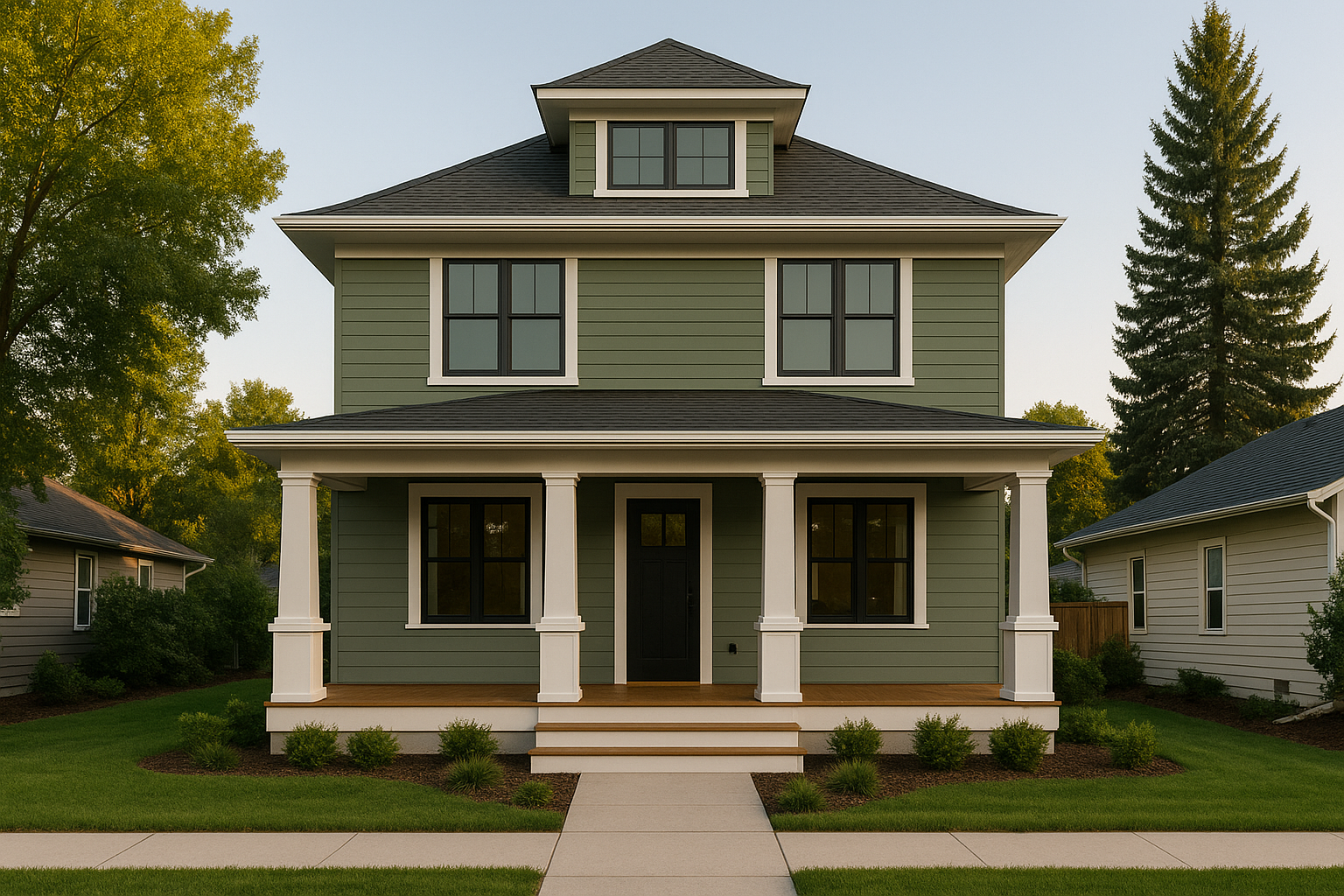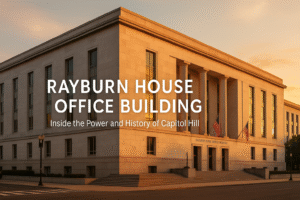Homes across America tell stories. One style, the American Foursquare, speaks of strength, purpose, and simplicity. You can spot it in old neighborhoods. It stands proud with a boxy shape and wide front porch. Its clean look helped it become one of the most loved home styles in the early 1900s. People called it the “Prairie Box” because of its square form and strong lines.
This home style rose during a time of change. The fancy Victorian style faded. Families wanted homes that felt solid, neat, and easy to build. The Foursquare offered just that. It had clear lines, a smart layout, and fewer decorative parts. That made it cheaper and faster to build. Builders across the country loved the idea. Soon, you could find this home in both cities and towns.
The Foursquare also fit American life. It gave families space without waste. Every inch had a use. The simple design made the home feel open. Its layout worked well for family life. Children could play upstairs. Parents could rest in the living room. The porch brought people together outside. Each part made sense.
This article explains why the American Foursquare home mattered. It looks at the history, design, and lasting features of this proud square house. If you want to understand a true American home style, this guide walks you through everything you need to know.
Where It All Began: The Roots of the Foursquare
The American Foursquare came to life around 1890. It grew strong during the early 1900s. Most historians agree that the style gained fame after the end of the Victorian era. At that time, many people grew tired of homes filled with tiny rooms and heavy decoration. They wanted something new.
The Foursquare gave them what they asked for. It kept things simple. It used fewer materials and less labor. This made it perfect for the rise of middle-class America. Magazines and catalogs helped spread the design. Sears, Roebuck & Co. and other companies sold Foursquare home kits. You could order one and build it yourself or hire a local builder.
This style worked in every part of the country. In the city, it stood on narrow lots. In rural areas, it gave farmers a modern, efficient home. Its design spoke the same message everywhere: strong, clean, and useful.
The Boxy Shape That Defines It
The name “Foursquare” comes from its shape. The home looks like a box. Most Foursquares have two full stories. Each floor has four main rooms. That makes it easy to plan, easy to live in, and easy to heat or cool.
The roof usually has a low pitch and a center dormer. The porch often spans the whole front of the house. Thick columns hold it up. Some homes use stone or brick; others use wood siding. Every choice depends on the region and the budget.
Inside, the layout stays the same in most homes. A living room, dining room, kitchen, and a hall or parlor fill the first floor. Bedrooms take up the second floor. Attics and basements add more space when needed. Each room feels balanced. You don’t waste any space.
DIY Home Renovation – Make Your Home Elegant From Tip to Toe On Weekends
Simple, Yet Flexible Style
One reason people love the Foursquare is its mix of styles. It does not stick to one look. Instead, it blends well with others. You might see a Foursquare with Craftsman touches-like built-in shelves or exposed beams. Another may include Colonial trim or even a bit of Tudor charm.
This flexibility helped the home stay popular for decades. It let families express their taste without changing the home’s shape. Builders could also match local trends. As long as the structure stayed square, they could add personal style in small ways.
You don’t need to guess when you see one. Its shape tells you. But the details often show you a mix of art, culture, and choice.
Why Families Loved It
The American Foursquare became a favorite for many reasons. First, it made smart use of space. Each room served a clear role. The wide hallways and tall ceilings gave the home a roomy feel. Natural light came through large windows.
Next, it was easy to clean and maintain. The straight lines made the home easy to build and fix. That saved time and money. In a time before power tools and home stores, that mattered a lot.
The porch gave neighbors a place to talk. It brought people out of the house. This helped build stronger communities. Families sat outside during warm evenings. Children played on the steps. It became a key part of the home’s charm.
The Sears Kit Homes and the Foursquare Boom
Sears helped the Foursquare grow fast. From 1908 to the 1940s, Sears sold home kits through its catalog. People could pick their style, pay, and get all the parts shipped by train. Instructions came with the wood, nails, windows, and plumbing. Then, you built it-or hired someone who could.
The American Foursquare made up a large number of these kit homes. It was perfect for the idea. Its simple shape and layout worked well with the plan. You did not need special tools or deep skills. That made homeownership possible for many first-time buyers.
Other companies sold similar kits. But Sears led the way. Today, many still stand strong. People now seek these kit homes for their history and charm.
Foursquare Homes in Modern Times
You can still find Foursquare homes today. They fill older parts of many U.S. cities. Some people restore them. Others update the inside but keep the old shape. The strong bones of the Foursquare make it easy to work with.
Homebuyers value their solid feel. They like the classic look. Many want real wood floors, wide trim, and deep porches. Foursquares offer all that. They give a mix of vintage charm and modern use.
Some builders now create new homes in the Foursquare style. These homes use better materials and modern tools. But the core idea stays the same: boxy, balanced, and bold.
What Makes a Foursquare Home Stand Out
An American Foursquare home stands tall with two full stories. Each floor holds four main rooms. This layout keeps the home balanced and easy to use. The shape of the house is square or very close to it. That shape gives it a bold, clean look.
At the top, you often see a center dormer on the roof. The roof itself sits low and slopes gently. It spreads out in all directions. This kind of roof is called a low-pitched hipped roof. It adds to the home’s boxy feel and helps shed water and snow.
The front porch draws attention. It runs across the width of the home. Thick, square columns hold up the roof over the porch. These columns give the house a strong and welcoming face. Many families enjoy sitting here in the evening or chatting with neighbors.
The design stays simple. You won’t find fancy trim or extra curves. Everything has a reason and a place. Deep roof eaves cast clean shadows and protect the sides of the house. These strong lines give the home a neat and tidy look.
Inside the home, wide wood trim frames the doors and windows. Large windows let in plenty of light. Each room feels open and bright. The layout allows for smooth movement from one space to another. Families can live, cook, eat, and relax without wasting space.
Most Foursquare homes also include an attic above and a basement below. These spaces give extra room for storage, work, or play. Homeowners often use the attic for bedrooms or offices. The basement often holds laundry, tools, or extra seating.
This home style gives flexibility without losing its shape. The design fits many tastes. You can update it or leave it as it was a hundred years ago. Either way, the Foursquare keeps its charm. Even today, it stands strong beside modern homes. Its clean shape, smart use of space, and timeless look continue to win hearts.
Why the Foursquare Style Still Matters
The American Foursquare tells a story about American life. It shows how design can match need. People wanted homes that worked hard and looked clean. The Foursquare gave them both.
It also proved that a home did not need to be large to feel complete. The rooms flowed well. The design kept costs down. And the look stayed timeless.
As cities grew and families changed, the Foursquare stayed. That says a lot. It means the design met real needs. Even now, more than 100 years later, people still love this style.
Final Thoughts
The Foursquare home tells a clear story. It came from a time of growth, work, and hope. America was changing. Towns grew fast. People moved from farms to cities. They needed homes that met their needs without extra cost. The Foursquare answered that call.
Its boxy shape was more than a style choice. It saved time, space, and money. Four rooms on each floor meant easy plans. Big porches brought neighbors together. Every part of the home served a real need.
These homes helped shape the look of many streets. They filled new suburbs and old towns. Builders loved them. Families trusted them. The Foursquare made life feel stable in times of change.
Today, these homes still feel right. Their clean lines, solid bones, and smart layout still fit modern life. They do not try to impress. They just work. That’s the beauty of it. The American Foursquare does not need to be loud to be strong. It stands in quiet pride.
When you walk past one, stop and look. You may see brick or wood. You may see a wide porch or a tall dormer. But look closer. You will see care in every , If you’re looking to blend timeless structure with modern elegance, explore our guide on Luxurious Unique Design Features for Your Home.




